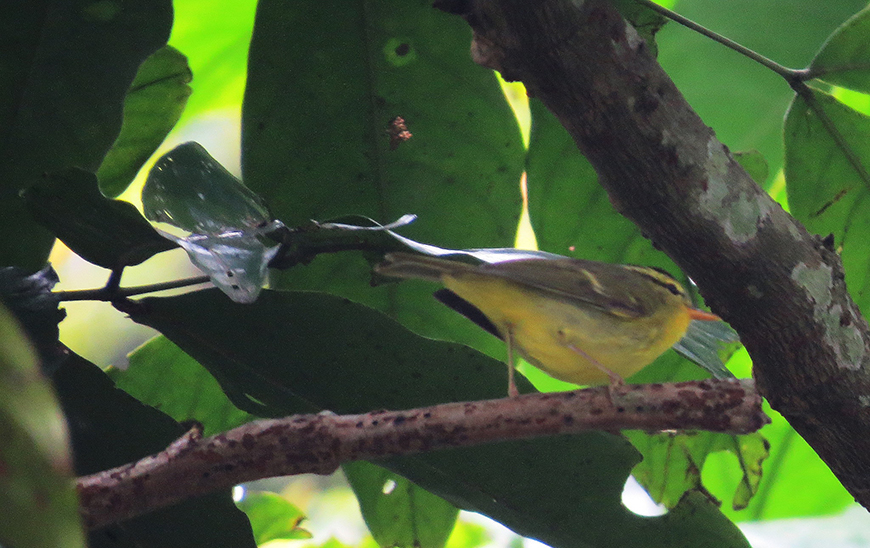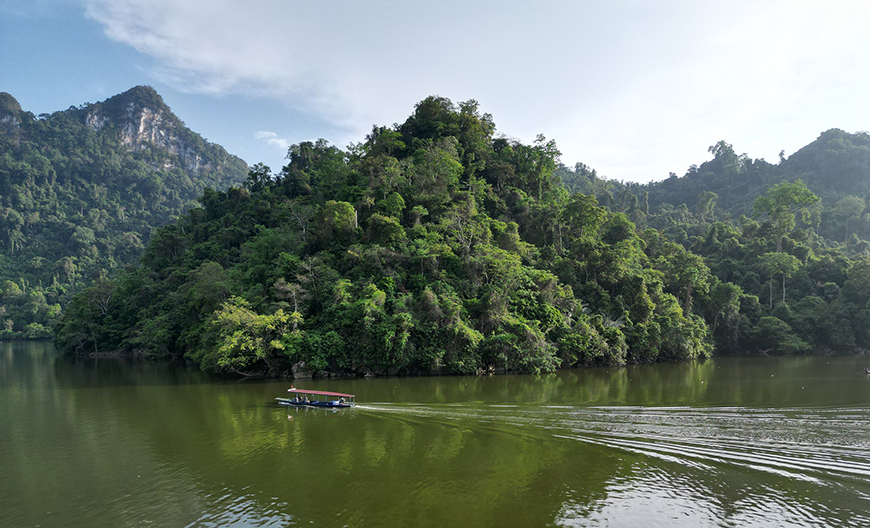Nestled in the northeast of Vietnam,
Ba Be National Park is a veritable
natural and scientific jewel. Created in 1992, this treasure trove covers more than 7,600 hectares and is home to exceptional biodiversity, a richness that earned it recognition as a
Biosphere Reserve by UNESCO in 2004, then as a RAMSAR site in 2011 - a distinction that testifies to its unique ecological value and fragile aquatic habitats.
►
Learn more : Walk through time in Ba Be National Park

Ba Be national park is a haven for bird watchers - Source : Mr Linh's adventures
A stunning landscape
Enter this natural sanctuary and let yourself be captivated by its breathtaking landscape. Karst mountains, sculpted by millions of years of erosion, rise majestically above verdant forests. At the heart of this breathtaking scenery, Ba Be Lake, sometimes nicknamed “the Bay of Three Emeralds”, unfurls its crystal-clear waters over almost 8 kilometers.
A biodiversity sanctuary
Much more than just a natural site, Ba Be National Park is an exceptional example of a balanced ecosystem, playing an essential role in conserving biodiversity and promoting sustainable development. Discover this jewel, a haven of peace for nature and science.
A haven of scientific research
Much more than just an enchanting landscape, Ba Be National Park is a veritable haven for scientific research. Since its creation in 1991, this natural setting has established itself as a living laboratory where teams of researchers devote themselves passionately to the in-depth study of this fragile ecosystem. At the heart of this nature reserve, scientists meticulously explore the flora and fauna, keeping a watchful eye on populations of endangered species. Their invaluable work provides a better understanding of the delicate balances that govern this unique environment, offering essential clues for effective conservation measures. But Ba Be National Park's role doesn't stop there. Pioneers in this field, researchers are also examining the impact of climate change, watching with concern how this ecosystem will evolve in the face of environmental challenges. At the same time, other studies are focusing on medicinal plants, exploring their potential properties in the service of humanity. Far from being a simple green setting, Ba Be is a living laboratory, an exciting field of study that is helping to advance knowledge of our planet's fragility and the means to preserve it.

Ba Boat trip on Ba be lake - Source : Mr Linh's adventures
Examples of notable scientific expeditions in Ba Be National Park
Ba Be National Park is home to exceptional biodiversity, as witnessed by several landmark scientific expeditions. In 2019-2020, a team of Vietnamese and international botanists carried out an in-depth study of the park's flora, listing more than 400 orchid species, including 15 new to science. This discovery underlines the incredible richness of this unique ecosystem.
Researchers are also studying the fate of the endangered white-handed gibbons that inhabit the park's forests. By studying their behavior and ecology, these scientists hope to better understand the challenges they face, an essential step in ensuring their long-term protection.
More recently, in 2021, a multidisciplinary team assessed the impact of climate change on the park's forest ecosystems. By analyzing climate data and observing vegetation transformations, these experts were able to identify the vulnerabilities of the environment and propose adaptation measures crucial to its future resilience.
These various expeditions bear witness to the importance of Ba Be National Park for scientific research. Thanks to this work, we are acquiring ever more in-depth knowledge of this extraordinary nature reserve, an essential asset for better preservation.
A sustainable tourism site
The park works closely with local communities to promote sustainable natural resource management practices. Organic farming and responsible fishing are promoted, helping to preserve the environment while supporting local livelihoods. Education and awareness-raising initiatives are also carried out to involve local residents in the protection of their living environment. The aim is to ensure the sustainability of the park's natural resources, a precious heritage that must be passed on to future generations. In addition, tourism within the park is subject to rigorous supervision, aimed at minimizing its impact on the environment. Visitors can enjoy a variety of outdoor activities, including hiking, kayaking and rock-climbing, while discovering the region's ethnic minority villages. An authentic and responsible experience, in the heart of a preserved natural environment. All these initiatives testify to the park's commitment to sustainable development, reconciling environmental protection with the well-being of local communities.
Ba Be National Park, an inspiring model of sustainable conservation
Ba Be National Park is one of Vietnam's jewels. Thanks to rigorous scientific commitment and close collaboration with local communities, the park has become a model of sustainable natural resource management. The park's conservation efforts are truly remarkable. The fight against poaching, deforestation and uncontrolled development is helping to preserve endangered species and their fragile habitats. This approach, involving authorities, scientists and local populations alike, makes Ba Be an example for other protected areas around the world.
Conclusion
Beyond its natural wealth, this park also harbors a
unique cultural heritage. The communities who have lived here for generations play an essential role in preserving this priceless ecosystem. When you visit Ba Be, you won't just be admiring breathtaking landscapes. You'll also be helping to safeguard a real treasure, for the benefit of future generations. For here, nature and mankind work together for a sustainable future.
Sources :
Official website of Ba Be National Park
Biosphere Reserve
Natural Heritage